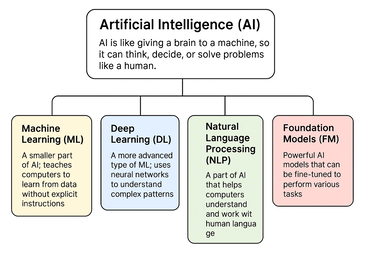What Is Artificial Intelligence and How Does It Work?
Imagine giving your computer a brain filled with intelligence—that’s AI. It thinks, learns, and makes decisions—just like humans.
AI can be categorized into 2 types:
- Weak AI (Narrow AI)
- Strong AI (General AI)
Weak AI (Narrow AI)
Weak AI (also called Narrow AI) is a type of artificial intelligence built to do one specific task, like:
- Answering questions
- Writing content
- Recognizing faces
- Recommending videos
It may seem smart, but it doesn’t actually understand or think like a human — it just follows patterns and rules.
Examples:
- Siri or Alexa
- ChatGPT, Gemini
Strong AI (General AI)
Strong AI is a type of artificial intelligence that can think, understand, and learn like a real human.
It wouldn’t just follow instructions — it would truly understand things, make its own decisions, and even feel emotions.
Important: Strong AI does not exist yet. It’s still a goal for the future — more like science fiction for now.
👉 Levels of AI: From Zero to Superhuman
AI systems can be understood in 6 levels, ranging from no intelligence to beyond human abilities:
-
Level 0: No AI The system is fully manual and doesn’t use any intelligence.
-
Level 1: Beginner AI Works about as well as a new learner or unskilled person (like what we see in most AI today).
-
Level 2: Average AI As good as a skilled human doing the job reasonably well.
-
Level 3: Expert AI As smart and capable as top professionals in the field.
-
Level 4: Master AI Better than almost all humans, performing at the
99% level. -
Level 5: Superhuman AI Smarter and faster than any human on Earth.
The Anatomy of AI
Artificial Intelligence (AI) is like an umbrella. Under it, there are smaller branches that go deeper and deeper. Let’s break it down.
